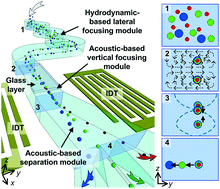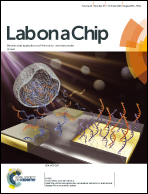High-throughput cell focusing and separation via acoustofluidic tweezers†
Abstract
Separation of particles and cells is an important function in many biological and biomedical protocols. Although a variety of microfluidic-based techniques have been developed so far, there is clearly still a demand for a precise, fast, and biocompatible method for separation of microparticles and cells. By combining acoustics and hydrodynamics, we have developed a method which we integrated into three-dimensional acoustofluidic tweezers (3D-AFT) to rapidly and efficiently separate microparticles and cells into multiple high-purity fractions. Compared with other acoustophoresis methods, this 3D-AFT method significantly increases the throughput by an order of magnitude, is label-free and gently handles the sorted cells. We demonstrate not only the separation of 10, 12, and 15 micron particles at a throughput up to 500 μl min−1 using this 3D-AFT method, but also the separation of erythrocytes, leukocytes, and cancer cells. This 3D-AFT method is able to meet various separation demands thus offering a viable alternative with potential for clinical applications.



 Please wait while we load your content...
Please wait while we load your content...
